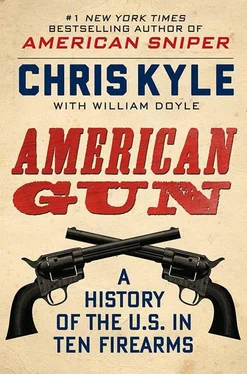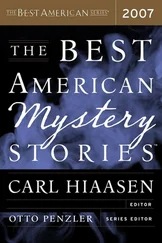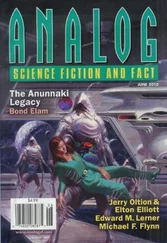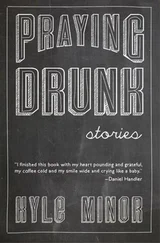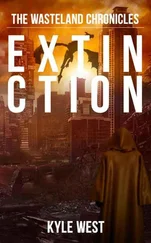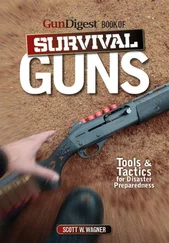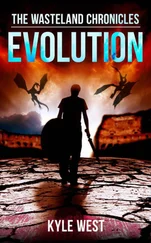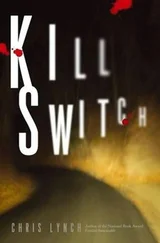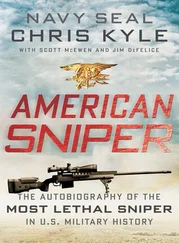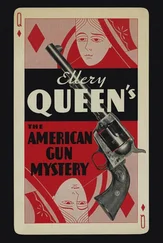Of course, there is another part to the story—firearms have also torn us apart, literally and figuratively. The Civil War, bank robberies, assassination attempts—the gun has been a tool for bad as well as good.
I first learned how to handle guns from my dad, who started teaching my brother, Jeff, and myself how to hunt and shoot before we could even ride bikes. He taught us to respect weapons as important tools, and part of that respect was knowing just a little bit about the history of the gun. I can’t swear that knowing Johann Nicolaus von Dreyse invented the first bolt-action rifle made me a better shot with one, but I do know that the tidbits of information I picked up along the way fired (if you’ll excuse the pun) a powerful fascination with our nation’s history. One of my proudest possessions is a replica Peacemaker—the famous Colt revolver that defined the Wild West. Take that bad boy in your hand and you’re transported back a hundred and fifty years.
There’s a saying that to really know someone you have to walk a mile in their shoes. I’d add that to really know our ancestors, we have to put on more than their shoes, which were generally poor-fitting and leaky. Hitch a plow to an ox and work a field for a few hours, and you come away with a whole new appreciation for what your great-great-grandpa did come spring on the Ohio frontier. Pick up a Kentucky long rifle and aim it at fleeing whitetail, and you’ll learn real quick about how important it is to use every bit of an animal you harvest; you may not have another one down for quite a while.
When I decided to do this book, I didn’t want to write a stodgy textbook, or sound like the teachers who used to put me to sleep in the back of the classroom. I aimed to talk history with the bullets flying: the critical single rifle shot of the Revolutionary War; the climaxes of the Battle of the Alamo and Custer’s Last Stand; Abraham Lincoln’s personal shooting range on the White House grounds. I wanted to explore some of the greatest U.S. military battles of the twentieth century; the St. Valentine’s Day massacre; and the North Hollywood bank robbery and shootout in 1997, which caused American police forces around the country to radically rethink their approach to firearms self-defense, and to gear up for combat.
To write this book, I traveled deep into American history. A team of friends and I read thousands of pages of historical documents, books, journals, military reports, and long-forgotten letters. I talked to firearms historians and reenactors, and I poked around museums and archives on the history of guns in America. I also had the thrill of personally handling and shooting many of these weapons.
I reached back into my own past, recalling gun stories we SEALs traded around a campfire in the middle of the combat zone in Iraq, and the tales my dad told me about our Texas ancestors and the guns they relied on. In the process I’ve learned to better appreciate the courage of the men and women who made America.
As I got further into this project, it became increasingly clear to me that guns have always been present at the leading edge of American history—often crucially. And along the way, certain revolutionary firearms seemed to shape the story of America more than all others.
I’ve picked ten guns to serve as the flagship weapons for our tour of America’s past. Now, I have to say, it’s my personal list. If you’re a gun-history buff, you’ll agree with some of my choices and disagree with others. I’m sure you’ll be scratching your head wondering why in the hell I didn’t talk about this Remington or that Smith & Wesson. I understand completely. A top-ten list is tough to settle on, and you may come up with a list of your own you like much better.
But that’s enough of a preamble. Let’s get ’er done.
—C.K.
On February 2, 2013, as this book was nearing its final stages, Chris Kyle was killed. A book may seem a small thing after a tragedy such as this. But American Gun was a piece of Chris that lay unfinished; and it was a project that was born out of his passions. For these reasons, there was never a question of whether we would see the book through to publication. Taya Kyle, his incredible wife, affirmed this immediately. She brought in Jim DeFelice, Chris’s coauthor on American Sniper , to team with William Doyle and wrap up the manuscript. Many of Chris’s friends were graciously on call to confirm facts and offer their insights. We believe we got the book right, but any errors are our own.
Lastly, no shadow hangs over these pages, despite the circumstances. Chris was full of more life, humor, and love of country than anyone who’ll ever cross your path. That’s the spirit you’ll be lucky enough to meet as you turn the page.
1
THE AMERICAN LONG RIFLE

“I never in my life saw better rifles (or men who shot better) than those made in America.”
—Colonel George Hanger, a British officer
On the morning of October 7, 1777, a young rebel named Timothy Murphy spat on his hands and began climbing up a tree in a field not far from Saratoga, New York. His progress was slowed by the weapon he gripped in his hand, but the gun was entirely his reason for getting up in that tree in the first place. Murphy was a Continental Army sergeant and a master marksman—a sniper in so many words. His weapon, a long rifle, was one of the few technologically advanced weapons the ragtag Continentals possessed during the Revolutionary War. His mission: to find and eliminate high-value targets in the ranks of the Red Coats mustering for attack a few hundred yards away.
Now, I may be a bit partial to Mr. Murphy, who like me was a sniper. But I think it’s not much of an exaggeration to say that the good sergeant and the other marksmen with him had the potential to change the Battle of Saratoga, and with that, the whole Revolution. They’d already harassed the daylights out of British General John Burgoyne and his troops. Burgoyne had a master plan to cut the American rebellion in two, slicing down New York’s Hudson River Valley. He was marching south; another general was coming north. If the two forces met in the middle, the Revolution was done.
But Burgoyne was having tough going. The Americans were better fighters than he thought. One reason they were whipping him was their tactics. The British army depended on close coordination on the battlefield. It was a thing of beauty to look at, assuming the Red Coats weren’t shooting at you. Groups of men marched in perfect precision, took their shots together, and made their bayonet charges like a well-oiled machine. But it all relied on well-trained officers and well-timed orders to keep things moving smoothly.
The Americans aimed to mess that all up by targeting those officers. In modern terms, we’d say they were zeroing in on Burgoyne’s command and control. Burgoyne couldn’t lead his army without its officers. That’s where Murphy and his fellow snipers came in. Their long-range shots sought to leave the Red Coat units headless.
If they could do that in this battle, the whole Revolution might turn around for them. The French king was looking on from the sidelines, wondering if he should support the Americans. If the Americans stopped the Brits here, not only would they have a huge victory, but maybe get some French guns and money to boot.
Not that Murphy was thinking about all that as he climbed the tree. He was just looking for a nice target to fire at.
Very soon, one rode into view: a British officer, buttons gleaming on his red coat. It was General Simon Fraser, the best British leader on the field, and the man commander John Burgoyne was counting on to save the British bacon today.
Читать дальше
